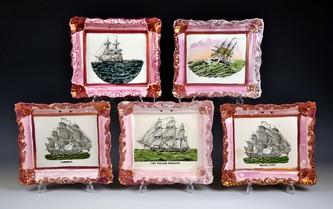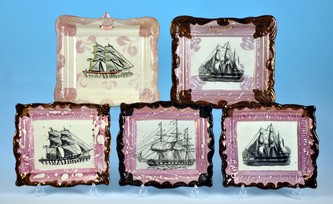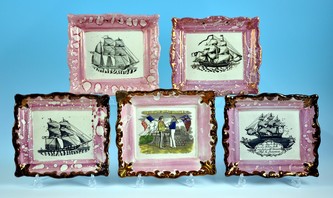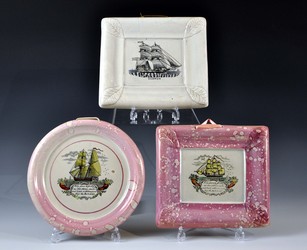Maritime plaques
Click on the images to enlarge. Click on the pages above to view individual plaques.
Sunderland or 'Garrison' Pottery (Dixon and partners)
|
The top two plaques and bottom right, have the impressed mark 'Dixon Co'. The bottom left has the 'Dixon, Phillips & Co' anchor mark. The left two plaques are titled 'NORTHUMBERLAND 74'. The circular plaque has the 'May Peace and Plenty' verse. The bottom right plaque has a later transfer titled 'GAUNTLET CLIPPER SHIP'.
|
The top right plaque, titled 'SAILORS' FAREWELL.', has the 'Dixon, Phillips & Co' anchor mark. The bottom centre plaque is titled 'SHIP CAROLINE' and is impressed 'Dixon Co'. Bottom left and right are two unmarked versions of 'THE MARINER'S COMPASS'. Although the bottom right plaque looks similar to the others, it is likely from a different pottery. The top left plaque, also unmarked, is titled 'MATE SOUND THE PUMP, MORNING NOON & NIGHT.'.
|
Moore and Co's Wear Pottery, Sunderland
The plaques below left likely date from c1840 onwards, and can be found on the less common and rare ships pages. The smaller plaques, below right, are from the 1850s. They are listed on the common ships page. A darker band of lustre framing the transfer is typical of Moore's.
|
Five larger size plaques with unusual scalloped corners. The top two with the impressed marks 'MOORE & Co' (top left) and 'MOORE & CO' (top right).The bottom three titled 'COMMERCE', 'THE VOLAGE FRIGATE', and 'RESOLUTION'.
|
Four more typical rectangular plaques with ship transfers, and one with scalloped corners for size comparison. Top: Duke of Wellington (impressed mark 'MOORE & Co'), and Euryalus. Bottom: Great Eastern, Commerce, and Victoria and Albert Yacht.
|
The brown-bordered plaques below are often attributed to Scott's pottery. However, my research suggests that these plaques were most likely made by Moore's in the 1860s. The confusion probably arises because during that period Moore's decorated items for Scott, and there are many bowls with these transfers and Scott impressed marks. The brown-bordered plaques are much more common than the plaques above with the same transfers.
|
Top: Crimea, with eagle, lion and flags; The Token or Jack's Safe Return. Bottom: Duke of Wellington; Mariner's Compass; La Bretagne.
|
Top: Great Eastern; Euryalus. Bottom: Brig; Star of Tasmania; Schooner. The last three transfers can be found on the less common or rare ships pages.
|
The use of some of these transfers continued into the 1870s, and they are often found on orange-lustre items.
Attributed to John Carr, Newcastle, and other non-Sunderland plaques
|
These common ship plaques aren't marked. The top two are on a shape associated with John Carr's Low Lights Pottery in North Shields. Designs on these round-cornered plaques often appear on smaller plaques (see bottom row) also attributed to Carr. The two left transfers are very similar, although untiled, to the Albion plaque, Gudrun (see below).
|
A group of unmarked plaques. The left two are attributed to Carr. The bottom centre is an early 20th century, Adams Pottery (Staffordshire), reproduction of a Crimean War plaque with French and English sailors carrying flags, and the text: 'MAY THEY EVER BE UNITED'. The top right plaque has a transfer associated with the Tyneside potteries, Maling an Fell. The bottom right has the 'May Peace and Plenty' verse.
|
Albion Pottery, Newcastle, and wide-bordered plaques
|
Three Albion Pottery plaques, c1864. Top: titled 'GUDRUN' and impressed circular mark 'ALBION POTTERY' with 'G&A' in the centre. This plaque has a large firing crack and was presumably sold as a factory second without lustre decoration. Below: two plaques with the verse 'May peace and plenty'. The rectangular one with an impressed circular mark 'ALBION POTTERY'.
|
Two smaller unmarked plaques with a similar wide border, though without a leaf modelled in each corner. It appears that Moore's acquired the Albion plaque moulds and used them with a limited number of transfers in the late 1860s.
|









